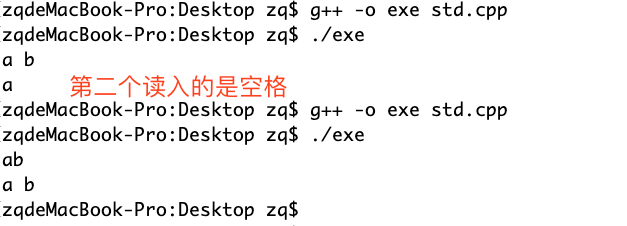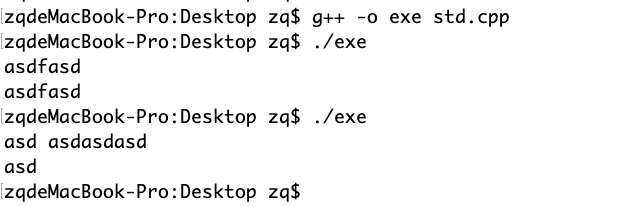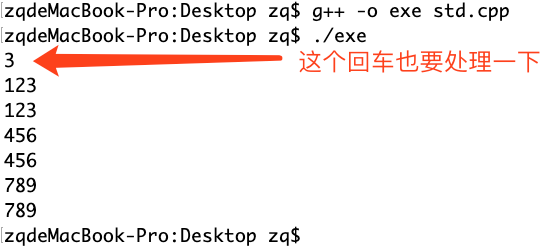参考:https://blog.csdn.net/a3192048/article/details/80303547
一般情况下的输入输出
#include <bits/stdc++.h>using namespace std;char c;string s1;char s2[110];char g[110][110];int main(){// 以字符为例cin >> c;cout << c << '\n';// 读入的数据组数未知的情况下while (cin >> c){}while (scanf("%c", &c) == 1){}// 读入string类cin >> s1;cout << s1 << '\n';// 读入字符数组scanf("%s", s2);printf("%s\n", s2);// 读入二维字符数组int n;cin >> n;for (int i = 0; i < n; i++) scanf("%s", g[i]);for (int i = 0; i < n; i++) printf("%s\n", g[i]);// int类型 占多少个字符宽度cin >> n;printf("%8d %8d\n", n, n);printf("%-8d %-8d\n", n, n);// double 类型保留小数点后几位printf("%.20lf\n", 1.0 / 3);// 格式化输出的内容,一般建议用printf()搞定,很少用coutdouble x = 3.1415926;cout << x << '\n';cout << setprecision(5) << x << '\n';cout << setprecision(4) << x << '\n';cout << setprecision(3) << x << '\n';cout << setprecision(2) << x << '\n'; // 3.1cout << setprecision(1) << x << '\n'; // 3// setprecision 不计算小数点// #include <iomanip>// 与 setw 字段宽度不同的是// setprecision 的精度设置将保持有效,直到更改为其他值为止// 流操作符 setw 可用于建立指定宽度的打印区域// 空格“填充”在前面,所以它被认为是右对齐的// 左对齐也能搞,麻烦// 用一回,写一回int y;cin >> y;cout << setw(8) << y << setw(8) << y << '\n';return 0;}
输入原理
程序的输入都建有一个缓冲区,即输入缓冲区。每次输入过程是这样的,当一次键盘输入结束时会将输入的数据存入输入缓冲区,而cin函数直接从输入缓冲区中取数据(cin读取数据是从第一个非空白字符开始到下一个空白字符结束)。正因为cin函数是直接从缓冲区取数据的,所以有时候当缓冲区中有残留数据时,cin函数会直接取得这些残留数据而不会请求键盘输入。
#include <bits/stdc++.h>using namespace std;int main(){string s;cin >> s;cout << s << '\n';cin >> s;cout << s << '\n';return 0;}

由于cin在遇到空格/tab时,就会停止读取,所以如果我在第一次输入时,利用空格隔开两个字符串,那么cin在第一次取的时候,只会读取前一个字符串,到空格结束,此时缓冲区还保留着前面输入的第二个字符串,那么第二次cin就会直接从缓冲区取残留数据,而不会请求输入。
当然对于以上的情况,也有解决的方案,那就是在第二次调用cin>>str之前通过cin.sync()来清空输入缓冲区。(后面有实验截图)
cin >>
根据cin>>sth 中sth的变量类型读取数据,这里变量类型可以为int, float, char, char*, string等诸多类型。这一输入操作,在遇到结束符(Space、Tab、Enter)就结束,且对于结束符,并不保存到变量中。注意:最后一个enter也在缓冲区。
#include <bits/stdc++.h>using namespace std;int main(){string s1, s2;char c;cin >> s1 >> s2;cout << s1 << ' ' << s2 << '\n';cin.get(c);cout << (int)c << '\n';return 0;}

cin.get( ) 读入一个字符
其中结束符意味着遇到该符号结束字符串读取,默认为enter,读取的字符个数最多为(长度 - 1),因为最后一个为’\0’。要注意的是,cin.get(字符数组名,接收长度,结束符)操作遇到结束符停止读取,但并不会将结束符从缓冲区丢弃
#include <bits/stdc++.h>using namespace std;int main(){char c1, c2;cin.get(c1);c2 = cin.get();cout << c1 << ' ' << c2 << '\n';return 0;}

getline(cin, s) 和 cin.getline(s, 110)
#include <bits/stdc++.h>using namespace std;string s1;char s2[110];int main(){getline(cin, s1);cin.getline(s2, 110);//cin.getline第三个参数表示间隔符,默认为换行符’\n’。读入不需要考虑最后的换行符。cout << s1 << '\n';printf("%s\n", s2);return 0;}

cin.ignore( )清空整个缓冲区
cin.ignore(1024, '\n');cin.ignore(); // 用该函数的默认情况,丢弃一个字符,即上次输入结束的回车符
其实该函数最常用的方式是这样的,将第一个参数设的非常大,将第二个参数设为’\n’,这样就可以缓冲区中回车符中的所有残留数据,因为一般情况下前面输入残留的数据是没有用的,所以在进行新一次输入操作前将缓冲区中所有数据清空是比较合理。
#include <bits/stdc++.h>using namespace std;int main(){char c1, c2;cin >> c1;cout << c1 << ' ';cin.ignore();cin >> c2;cout << c2 << '\n';return 0;}

#include <bits/stdc++.h>using namespace std;int main(){char c1, c2;cin >> c1;cout << c1 << ' ';cin.ignore(1024, '\n');cin >> c2;cout << c2 << '\n';return 0;}

gets( ) 读入字符串 unsafe
http://c.biancheng.net/cpp/html/260.html
C语言gets()函数:从流中读取字符串
#include <bits/stdc++.h>using namespace std;char s[110];int main(){gets(s);printf("%s\n", s);return 0;}

getchar( ) 读入一个字符
https://www.runoob.com/cprogramming/c-function-getchar.html
从标准输入 stdin 获取一个字符(一个无符号字符
#include <bits/stdc++.h>using namespace std;char c;int main(){c = getchar();putchar(c);puts("");return 0;}

scanf( ) 读入字符数组
#include <bits/stdc++.h>using namespace std;char s[110];int main(){scanf("%s", s);printf("%s\n", s);return 0;}

getchar( ) 读入字符数组
#include <bits/stdc++.h>using namespace std;char s[110];int main(){int i = 0;while ((s[i] = getchar()) != '\n') i++;printf("%s", s); //注意这个地方,我并没有 \nreturn 0;}
get( ) 读入字符数组
#include <bits/stdc++.h>using namespace std;char s[110];int main(){cin.get(s, 110);printf("%s\n", s);return 0;}

//多行数据读入的时候#include <bits/stdc++.h>using namespace std;char s[110];int n = 3;int main(){while (n--){cin.get(s, 110);getchar(); //把行末的回车读进来,否则翻车printf("%s\n", s);}return 0;}

#include <bits/stdc++.h>using namespace std;char s[110];int n;int main(){cin >> n;getchar();while (n--){cin.get(s, 110);getchar(); //把行末的回车读进来,否则翻车printf("%s\n", s);}return 0;}



